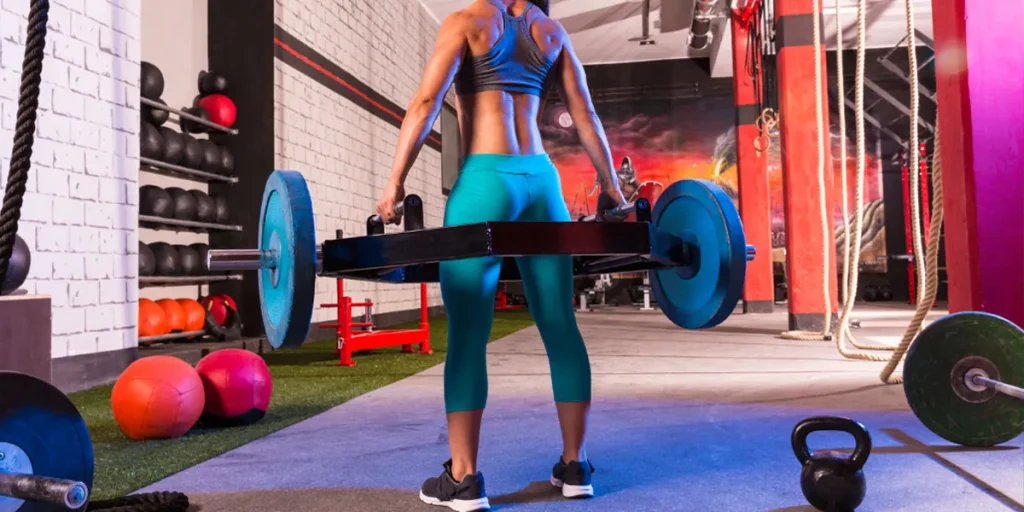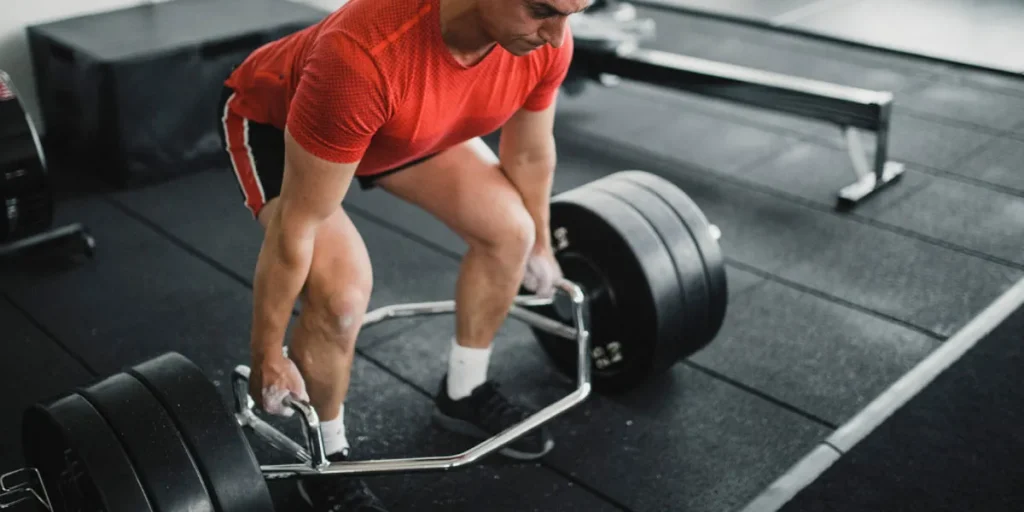Deadlift bars typically weigh 20 kilograms (44 pounds). The standard Olympic bar used in powerlifting is also 20 kg.
A fundamental piece of equipment for any strength training enthusiast, the deadlift bar is an essential tool designed for one of the most effective compound exercises—the deadlift.
Not to be confused with regular Olympic bars, deadlift bars are built specifically to withstand the rigors of heavy lifting, often accommodating weights that can exceed hundreds of kilograms.
Their standout features include a slightly longer length, added flexibility, and a knurling pattern that ensures a secure grip. This makes them a staple in both home gyms and professional fitness centers.
A proper understanding of deadlift bar specifics, including their weight, can facilitate better performance and inform your lifting technique.
Whether you’re a seasoned lifter or a newcomer to the world of weightlifting, knowing the characteristics of your equipment is key to maximizing your workout safely and effectively.

Deadlift Bars Unveiled
Anatomy Of A Deadlift Bar
Deadlift bars are unique. Longer than standard bars, they boast specific features:
- Length: Typically, they measure over 7 feet.
- Weight: Usually around 45 pounds.
- Diameter: Slightly thinner for a firm grip.
- Load capacity: Designed to hold heavy weights.
- Whip: More flex helps lifters during the pull phase.
- Knurling: Aggressive to prevent slipping.
Standard Vs. Specialty Bars
| Bar Type | Length | Weight | Main Use |
|---|---|---|---|
| Standard Olympic Bar | 7 feet | 45 pounds | General lifts |
| Deadlift Bar | >7 feet | 45 pounds | Heavy deadlifts |
Tipping The Scales
Knowing the weight of a deadlift bar is crucial. It affects performance and safety. Different types of bars vary in weight.
It’s not just about the plates you add. The bar itself sets the stage for your lift.
Average Weight Of Deadlift Bars
Deadlift bars aren’t one-size-fits-all. The average deadlift bar weighs about 20 kilograms (44 pounds).
Competition bars maintain this standard weight. Your gym’s bar might differ slightly. Check for labels or ask staff to be certain.
Factors Influencing Bar Weight
Several factors change a bar’s weight. Material, size, and type are key. Let’s break it down:
- Material: Steel varies in density. Higher quality steel might be heavier.
- Size: A longer bar can weigh more due to extra material.
- Type: Specialty bars like ‘trap’ or ‘safety squat’ bars can weigh more.
Manufacturer specifications also play a role. Always look up the specs for your particular bar.
Impact Of Weight

Understanding The Impact of Weight on deadlift bars is key for everyone interested in weightlifting.
Bar Weight On Lifting Performance
Deadlift bars vary in weight. Standard bars often weigh 20kg (45lbs). When lifting, the weight of the bar is crucial.
It affects grip, form, and power. A heavier bar can challenge stabilizing muscles. But a lighter bar might not prepare you for competitions.
Most official competitions use standard weight bars.
- Increased bar weight can lead to greater muscle engagement.
- Lighter bars can be good for beginners or warm-ups.
- Consistent training with a standard weight bar improves lifting techniques.
Safety Considerations
Safety is paramount when choosing the weight of a deadlift bar. Beginners should start with lighter weights. This allows a focus on form.
Proper lifting techniques prevent injuries. Using the wrong weight can lead to strain or accidents. It is best to increase the weight gradually.
| Weight | Safety Tip |
|---|---|
| Less than 20kg (45lbs) | Ideal for form practice and warm-up. |
| 20kg (45lbs) | Standard for regular training and competition preparation. |
| Over 20kg (45lbs) | Only for experienced lifters with solid technique. |
Choosing The Right Bar

Finding the perfect deadlift bar requires knowledge. Deadlift bars vary in weight, build, and capacity. A suitable bar ensures a satisfying and safe lifting experience.
Weight Capacities And User Needs
Deadlift bars come with different weight capacities. Some can handle 500 pounds while others support over 1000. Consider your strength level and goals before choosing.
- Beginners may opt for a bar with a lower weight limit.
- Experienced lifters should look for higher weight capacities.
Always check the bar’s maximum weight limit. You want room to grow in your lifting abilities. Ensure the bar can handle at least 20% more weight than you currently lift.
Material And Build Quality
The build and material of a deadlift bar impact performance and durability. Quality deadlift bars are usually made of
| Material | Features |
|---|---|
| Steel | Durable and strong |
| Alloy | Lightweight yet sturdy |
High-quality bars have a fine knurling for grip without causing hand damage. Check the bar’s finish too. A good finish protects against rust and wear.
- Look for a chrome or zinc finish for longevity.
- Avoid bars with poor welds or weak joints.
Care And Maintenance
To keep deadlift bars ready for action, proper care is key.
The right maintenance can prevent damage. It also makes sure the bar supports weight safely every time.
Prolonging Bar Lifespan
Long-lasting bars need routine care. Follow these tips to increase your bar’s life:
- Store bars horizontally to avoid bends.
- Use a nylon brush to clean chalk and dust.
- Oil the bar lightly to ward off rust.
- Avoid dropping bars with no weights.
- Keep in a dry area to prevent moisture damage.
Common Wear And Tear Issues
Deadlift bars face certain common issues over time. Watch for these and act fast:
| Issue | Cause | Fix |
|---|---|---|
| Rust | Moisture and Sweat | Clean and oil regularly |
| Bending | Improper use or storage | Correct storage and usage |
| Rough Sleeves | Normal wear | Polish and inspect for burrs |
In The Weight Room
Exploring the weight room, enthusiasts understand that deadlift bars hold significant importance in strength training. These bars are not your standard gym equipment.
Their weight alone can intimidate beginners and challenge the seasoned lifters. Yet, they are a staple for those looking to build power and improve lifting technique.
Proper Deadlift Techniques
Mastery of the deadlift begins with proper technique. It ensures safety and maximizes effectiveness. Proper technique allows lifters to engage the right muscles:
- Stand with feet hip-width apart, with the bar over your mid-foot.
- Grip the bar firmly, hands just outside the legs.
- Bend at the hips and knees, lowering your hips and keeping your chest up.
- Drive through your heels to lift the bar, keeping it close to your body.
- Lockout at the top with strong hip and knee extension.
Every rep should follow these steps to ensure you are lifting efficiently and preventing injury.
Training With Varied Bar Weights
Understanding the weight variations of deadlift bars can enhance training sessions. Different bar weights offer unique challenges and benefits:
| Type of Deadlift Bar | Weight |
|---|---|
| Standard Bar | 20kg (44lbs) |
| Women’s Bar | 15kg (33lbs) |
| Training Bar | 5-10kg (11-22lbs) |
| Trap/Hex Bar | 30kg (66lbs) |
Varying the deadlift bar weight during your training can improve your adaptability and strength.
Beginners should start with lighter bars and gradually increase the weight as their form and muscle strength improve.
FAQs About the Weight of Deadlift Bars
What Is The Standard Weight Of A Deadlift Bar?
The standard deadlift bar typically weighs 20 kilograms (44 pounds). It’s designed to be durable and handle heavy loads, catering specifically to powerlifting requirements.
Can Deadlift Bars Vary In Weight?
Yes, deadlift bars can vary in weight. While the standard weight is 20 kilograms, some bars designed for specialty uses or training might weigh slightly more or less, generally ranging from 15 to 25 kilograms.
How Much Weight Can A Deadlift Bar Hold?
A typical deadlift bar is capable of holding up to 1,000 pounds or more. However, competition-grade bars are often tested for higher weights and can handle loads exceeding 1,200 pounds.
Are Olympic And Deadlift Bars The Same Weight?
No, Olympic and deadlift bars are not the same weight. Olympic bars commonly weigh 20 kilograms, just like standard deadlift bars, but they are designed differently for varied lifts. Deadlift bars might be slightly heavier and are more flexible to maximize deadlift performance.
Conclusion
Wrapping up, standard deadlift bars typically weigh 45 pounds. Specialty bars might differ in heft, ranging from 55 to 65 pounds.
Understanding this helps lifters align their training with their capabilities and goals. Keep the bar weight in mind to track your progress accurately and safely push your limits.
Resources:
https://repfitness.com/blogs/guides/what-is-a-deadlift-bar-and-do-i-need-one
